To understand how to draw a leopard using different tools, you need to study the instructions with detailed descriptions of each step, as well as familiarize yourself with the list of additional materials that may be needed for drawing together with children.
What do you need to draw a leopard?
The items required for the work are listed in the table.
| Simple pencils | They are needed to make sketches and draw small elements of the picture. |
| Sharpener | All pencils should be sharpened before use. |
| Eraser | It must be of high quality so that the graphite does not smear on the paper, but is easily erased from its surface. |
| Art brushes | To paint with different colors, you need wide, medium and thin brushes. The bristles can be natural or artificial. It is desirable that the set contains soft and hard brushes. |
| Paper | Pencil drawings can be done on regular album sheets. For paints and artistic pastels, thick sheets with a rough surface are needed. |
The color scheme of the drawing depends on the style in which it is made.

Usually 4 colors are enough to color a leopard:
- light brown;
- dark brown;
- black;
- orange.
Paints or pencils of other shades can be useful for decorating the background or coloring elements of clothing if the leopard is drawn in a humanized, cartoon style.
Step by step instructions for drawing with a simple pencil
The leopard (a drawing for children over 10 years old should be realistic so that the child learns to maintain the correct proportions when depicting animals) differs from other types of large cats by its spotted coloring. This feature can be depicted even in a black and white drawing. For work, you need 3 pencils of different degrees of hardness: "HB", "H2" and "B2".
Sketching
The sketch is the basis of the future drawing. The outline of the animal's body is drawn with a hard pencil "H2" so that later other details can be correctly placed.
How to sketch:
- The picture will depict a leopard during hunting. When the predator sneaks up on the victim, it presses itself to the ground, so its head and body will be at about the same level. You need to draw 2 circles: the small one is the head, the medium one is the middle of the body. The back of the body will be larger than all the others, so after the middle circle you need to draw a large oval.
- Connect the middle circle and oval with smooth lines. The predator's back will be slightly arched.
- The head needs to be slightly lengthened in the muzzle area.
- Finish drawing the animal's neck. It should be wider at the base, as the leopard has a large chest.
- Use ovals to mark the places where the paws and body are connected.
- On the head, show the location of the ears and eyes.
- Finish drawing the hind and front paws. They need to be depicted schematically. Let one of the front paws be slightly set back, and the other, on the contrary, protrude forward. The same goes for the hind paws - the one that is closer will be behind, and the second, which is located on the other side of the animal, let it move forward slightly.
- Draw a long and curved tail for the leopard.
- Connect all the individual parts of the paws with smooth lines. Draw the toes.
- On the head, draw a line dividing the jaws.

Use the eraser to erase all auxiliary lines, leaving only the outline of the body.
Drawing details
Replace the hard pencil with another one marked "HB".
- Trace the resulting silhouette along the contour.
- Draw the shape of the head more clearly. Add ears, draw eyes.
- Finish drawing the nostrils.
- Draw the mouth slightly open, showing sharp teeth inside.
- Mark the shape of the cheekbones with an arched line.
- Draw spots in the form of circles all over the leopard's body.
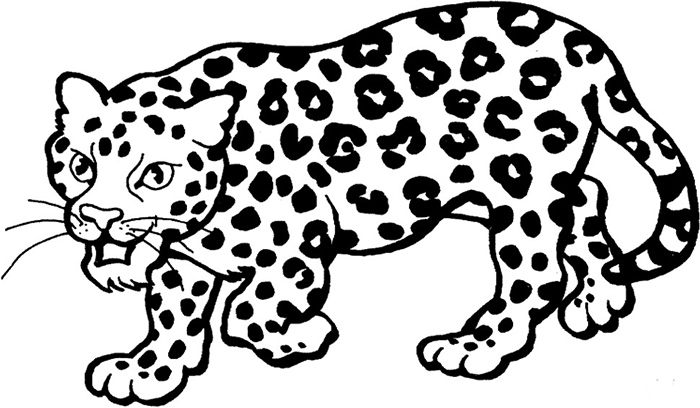
To make the coloring look as natural as possible, the spots should be of different sizes. On the paws and near the muzzle, they should be drawn small. On the back, sides and tail, on the contrary, large. In places where the spot goes beyond the outline, you can draw half a spot.
Coloring and shading
You need to color the leopard spots with a soft B2 pencil.
- Small spots should remain black. At the tip of the tail, some circles can also be completely filled with dark strokes.
- Large spots on the back, belly and sides should be painted as if they consist of smaller dark spots. Inside each circle the shading should be light, and at the edges dark, with gaps, as if there are 2-3 more dark and very small spots around the light spot.
- Place a few dots where the leopard's whiskers grow.
- Show the protruding hair on the chest, belly and withers with a zigzag line.
- Trace the outline of the leopard.

The space under the animal's paws should be darkened with strokes without pressing too hard. The shadow will indicate that the leopard is sneaking along the ground, not hovering in the air.
Pattern variations
A leopard (a drawing for children should be appropriate for their age and complexity of execution) in the drawing can look realistic, or, on the contrary, resemble a cartoon character. A large spotted cat can be depicted as menacing or cheerful and kind. Everything depends on the chosen drawing style.
The article below provides instructions on how to create several variations of leopard designs, varying in difficulty.
How to draw a leopard with markers
First, you need to draw a sketch with a simple pencil, and then color the picture in different colors.
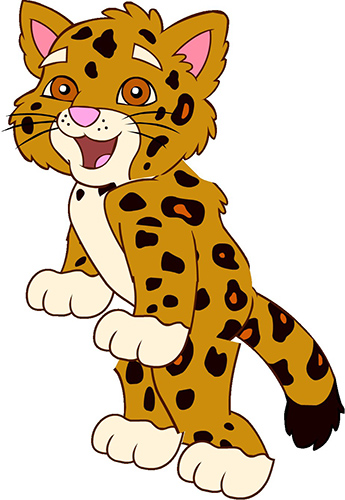
Procedure:
- Draw a round head, neck and an elongated oval body.
- Add 4 paws. The front ones should be narrower than the back ones. Since the leopard in this picture is shown from the side, the paws that are in the foreground should be slightly pulled back, and those that are on the other side of the body will stick out forward, as if the animal is walking, not standing.
- Use short, arched lines to show the toes on the paws.
- Finish drawing the tail, slightly curved and raised upwards.
- Draw ears on the head, as well as a nose in the shape of an inverted triangle.
- Mark the cheeks.
- Draw almond-shaped eyes with large irises and small pupils.
- Draw the lower jaw, show the area near the nose where the mustache grows and put a few dots there.
- Draw spots for the leopard in the form of ovals and circles. The spots on the paws and head should be smaller in diameter than those in the middle of the body.
- The breast should be left clean and free of spots.
- Now you can color the leopard. Use a beige marker to color his chest, cheeks, the area where his whiskers grow, and the inside of his ears.
- Paint the body and head with orange or light brown, without touching the spots.
- The spots themselves can be painted in 3 colors: yellow, dark brown and black.
- Draw the mouth in red.
- Color the irises with a yellow marker and the pupils with black.
- Make the nose brown.
- Use a black felt-tip pen to outline the picture and all the small details. Draw thin whiskers on the animal.
You need to color the picture with felt-tip pens carefully, avoiding the strokes "going beyond the outline." This style of drawing is suitable for children from 6 to 8 years old.
Leopard - the symbol of the Olympics, drawn with colored pencils
The leopard was one of the symbols of the 2014 Olympics. Emblems, banners and posters depicted it in a cartoon style, where the big predatory cat looked friendly. Many children liked it, and they tried to depict it in their drawings. To draw the Olympic leopard, you will need colored pencils.
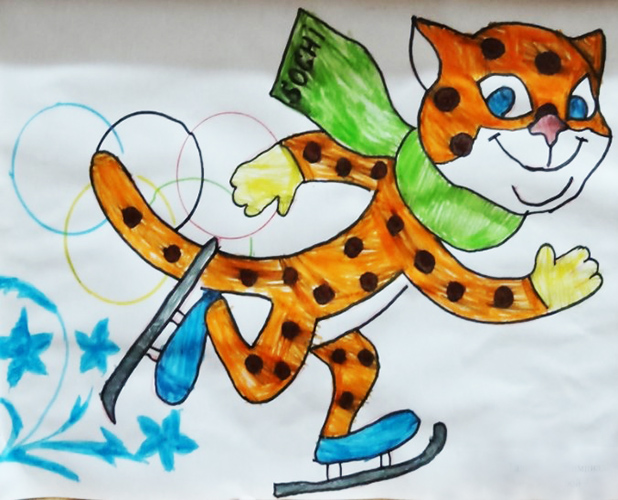
Procedure:
- Draw a round head with a grey pencil.
- Draw another circle under the first one, a little bigger, this will be the leopard’s body.
- Finish drawing the legs with large oval feet.
- Draw the front paws as hands behind the back.
- Shape the face, draw large almond-shaped eyes, cheeks, lower jaw and nose.
- Finish drawing the pointed ears.
- There will be a belt on the leopard's waist. It should be depicted as 2 parallel horizontal lines.
- On the tips of the hind legs, depict the position of the toes with 2 arched lines.
- Separate the breast.
- Draw a long, thick tail raised upwards.
- The spots are depicted as circles of different sizes.
- Use a beige pencil to color the chest, cheeks, lower jaw, as well as the toes and inner parts of the ears.
- Paint the body and head with light brown.
- Paint the whites of the eyes light green and the iris dark green.
- Make the spots brown.
- Color the belt with a blue pencil.
Trace the outline of the picture with a black pencil.
How to paint a leopard in watercolor
The leopard (it is advisable to do the drawing on large-format paper for children under 7) can look refined and elegant in the picture. This style of drawing demonstrates the grace of this animal. For work, you will need thick paper with a rough surface. It absorbs excess paint well and does not allow it to spread.
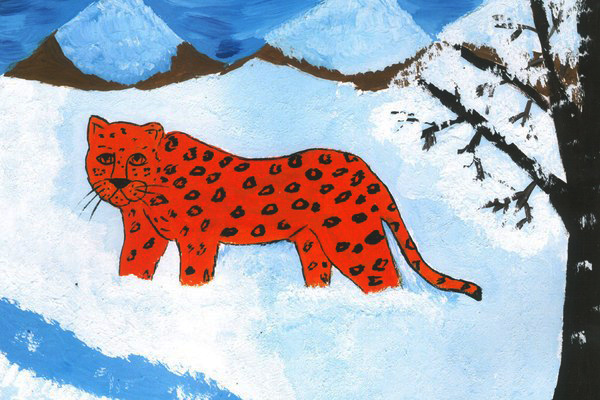
How to draw:
- Mix equal parts orange and white watercolor. Use a medium-sized brush to draw the silhouette of a sitting cat. The body should be elongated, the paws thin. The back of the body should be larger than all the others.
- Draw the head in the form of an oval, and then draw fluffy cheeks, the fur on them will curl upward.
- While the first layer of paint is not dry, you need to take orange color and with a soft-bristled brush darken some areas of the body. First, paint the top of the head.
- Darken 1 front leg, back and lower body. Belly and neck should remain light.
- The orange paint should be well shaded so that the boundaries of the transition to the light shade become almost invisible.
- Draw a long, thin tail on the leopard, lying on the ground.
- Draw the ears with dark brown paint.
- Dry the drawing.
- Use a thin brush to draw the muzzle. Draw closed eyes in the form of stripes.
- Draw the mouth in the shape of a wide letter "W".
- Draw the nose in the shape of a small heart.
- Add a few small spots on the head.
- Place spots all over the animal's body, on the paws and tail. Leave the chest and belly without spots.
- Using a very thin brush, draw whiskers on the leopard's face and mark the toes on its paws.
There is no need to outline the picture. A few thin dark brown lines will suffice, visually separating the front legs and chest from each other.
Mother leopard and her kitten, painted with gouache
This drawing will depict a mother leopard and her kitten, looking out of the grass. There are no very small details, and you will not have to build a complex sketch taking into account the proportions of the bodies. Therefore, this style of drawing is suitable for preschool children, over 5 years old.
How to draw:
- Using a simple pencil, draw the head of a large leopard, as well as the neck.
- Finish drawing the ears, eyes, nose, cheeks and lower jaw.
- Draw the kitten's head below. It will be 2 times smaller than its mother.
- Draw semicircular ears for the kitten, add eyes, cheeks, a nose and an open mouth.
- Draw some grass at the bottom.
- Now you can start coloring the picture. Use a medium-thick brush to pick up orange gouache and completely paint over the mother and kitten. Leave only the cheeks and eyes white.
- Paint the part of the sheet where the grass is drawn light green. It is not necessary to show each blade of grass, you can apply the color as a solid spot. You can add detail to the drawing a little later.
- Paint the background with blue paint. If the palette only has blue, it should be mixed with white gouache in a 1:2 ratio (there should be less blue than white).
- Allow the paints to dry completely.
- Now you will need a thin brush with soft bristles and black gouache.
- Trace the outline of the mother and kitten. Draw the hairs sticking out on their heads and chests.
- Outline the eyes and color the nose black.
- Outline the cheeks with thin, broken lines.
- Select the pupils inside the eyes.
- Add a mustache.
- Design the inner parts of the ears.
- The spots can be painted with a medium-thick brush with hard bristles. Dip the brush in black paint and press it where the spots should be. The spots on the head should be smaller than in other places.
- Take a thin brush again and sketch out the blades of grass.

Instead of black, you can use dark brown gouache.
Finger painting for the little ones
Children under 3 years old cannot draw contours yet and do not know what proportions are. Therefore, they can be offered to color a ready-made drawing. For the development of motor skills, it is useful for children to paint with finger paints. Such paints are sold in stores for children's creativity. They are washed off hands with wet wipes and do not cause allergic reactions on the skin.
How to draw a leopard with a child under 3 years old:
- An adult draws the silhouette of an animal on an A4 sheet of paper. It is not necessary to maintain exact proportions, the main thing is that the animal resembles a cat.
- Place 4 cans of paint in front of the child: yellow, orange, black, brown.
- First, ask your child to dip his fingers in yellow and paint the picture with fingerprints. The paint can be applied in a thick layer. This will be the main color of the leopard skin.
- Then give the child some orange paint and show him how to put spots on the leopard by making marks with one finger.
- Make several brown spots in the same way.
- Draw the animal's nose and eye in black.
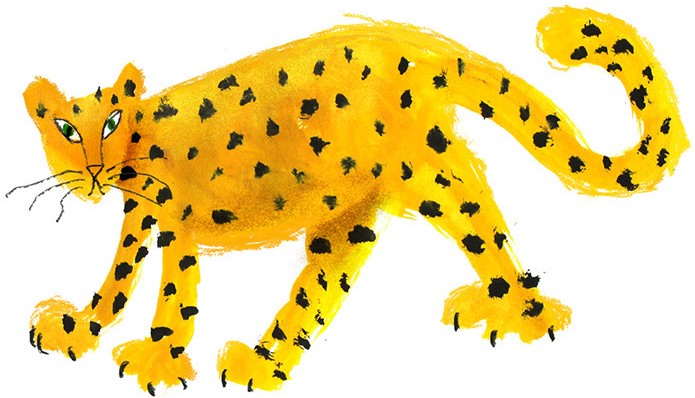
If the child wants, let him add a few more black spots on the leopard's body. Let the drawing be colorful and bright.
Leopard in a "cute" style, drawn with artistic pastels
A leopard (a drawing for children made in this style can become a decoration for their personal diaries) in a "cute" style is not at all like a real animal. It has a small body, a huge head and big round eyes. This style of drawing came from Japan. Animals drawn in this technique look very cute and cause delight.
How to draw a leopard with artistic pastels:
- Use beige chalk to draw a large head with pointed ears.
- Draw a small body with short legs.
- Add a short, curved tail.
- Shade the entire sketch and blend the beige color.
- Take a pink chalk, color the inside of the ears, and also darken the chest, the right side of the head, the belly and the base of the tail.
- Draw the nose in the shape of a small inverted triangle.
- Using dark brown chalk, draw 2 large round eyes.
- Outline the nose.
- Draw lots of spots all over the body, as well as on the head and tail.
- Paint the tops of the ears.
- Finish drawing the mustache.
- Outline the leopard with a thick line.
- Fix the drawing by spraying it with hairspray. When the picture dries, use white pastel to draw highlights inside the eyes.
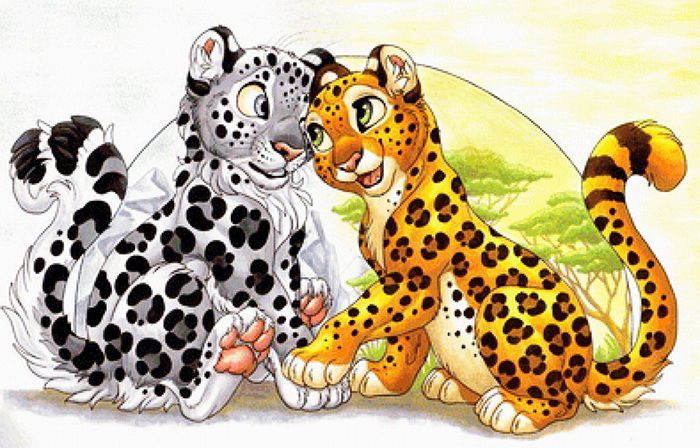
This drawing technique is suitable for children over 10 years old.
Examples of images for copying, tips for beginners
Tips for young artists and their parents:
- In order for an older child to learn how to draw animals, observing the correct proportions of their bodies, he needs a sample from which to copy. You can use a photo of a real leopard or choose a picture with a drawing in a realistic style.
- Preschoolers can be offered to draw a leopard in a cartoon style. This will help to keep the child's interest and allow him to show his imagination.
- Pencil drawings need to be fixed with special sprays or hairspray so that they do not smudge or stain other sheets of paper during storage.
- It is more convenient to draw hairs with brushes with hard bristles. If you do not press on the tool, its hairs will leave multi-layered stripes imitating wool.

When drawing a leopard with children, adults should talk about the lifestyle of these animals and their habitat. For general development, it will be useful for a child to learn why a leopard needs spots, how fast it can run, and what it likes to hunt.
Video about drawing
Master class on drawing a Leopard in the jungle:
